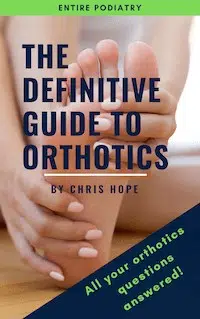It may not be the first thing you think of, but if you’re experiencing low back pain or hip pain, it could be related to your feet, as the position of your feet can affect your posture and the position of joints higher up the body.
Hip pain is a common symptom that can be related to a number of different conditions. For example, conditions such as arthritis, tendonitis, bursitis and strain injuries can affect the hip and cause pain in this joint. Hip pain can also be related to general postural deficiencies, muscle weakness and pelvic instability.
Leg length discrepancy (LLD), where one leg is shorter than the other, is also a common source of low back and hip pain. The effects of a leg length discrepancy can be alleviated through the use of orthotics and footwear modifications to improve posture and alignment.
What do feet have to do with hip pain?
The hip joints and the position of our hips can be affected by the biomechanics of our feet and legs. The following are some examples of how hip pain can be associated with foot function:
- Excessive heel eversion can cause excessive internal rotation at the neck of the femur (where the femur joins the pelvis to form the hip joint). This in turn impacts on proper alignment of the hip joint and can result in hip pain.
- Conditions such as hip bursitis (inflammation and pain in the hip) can be caused by instability or poor alignment of the pelvis. Ensuring proper biomechancs of the feet and legs can help to improve pelvic alignment.
- Hip pain can be associated with a Leg Length Discrepancy (LLD) (where one leg is shorter than the other). This sometimes occurs following hip replacement surgery. Podiatry treatment is able to address LLD, improving posture and joint alignment.
Hip pain can also cause secondary problems in the feet. For example, hip pain related to weakness of muscles around the hip (such as the gluteus medius muscle) will have implications further down the kinetic chain, as represented below:
- Weakness of muscles around the hip
- Excessive adduction and internal rotation of the femur (thigh bone)
- Increased angle of genu valgus of the knee (“knock-knees”)
- Internal rotation of the tibia
- Increased weight transfer to the medical aspect of the foot (over-pronation)
The resulting excessive and/or prolonged pronation of the foot can increase the risk of other conditions developing, such as medial tibial stress syndrome (shin splints) or Achilles tendonitis. There may also be associated knee pain (patellofemoral pain syndrome).
What can a podiatrist do for my hip pain?
A podiatrist will be able to assess the function of your feet and lower legs, to determine whether your feet are contributing to your hip pain. This will involve an initial examination including history of symptoms, biomechanical assessment and gait evaluation. In order to confirm whether your foot function is contributing to hip pain, we may use temporary measures (such as strapping or padding) to test whether this helps to reduce your hip pain.
If it does appear that foot function is playing a role in your hip pain, then your podiatrist can offer treatment to correct biomechanical function of your feet and legs:
- In many cases of hip pain associated with foot function, custom foot orthotics is the most effective treatment to improve foot function. Orthotics can help to correct movement of the feet and relieve associated pain in other joints.
- Exercises may also be recommended. For example, if hip pain is found to be related to muscle weakness then strengthening exercises may be prescribed.
- If hip pain is associated with Leg Length Discrepancy (LLD) then a CT scanogram may be required to measure the discrepancy. Heel raises can be manufactured to provide the exact required height to correct the LLD.
- Supportive footwear is another critical component of improving biomechanics of the feet. At Entire Podiatry we are able to provide advice on footwear that will be suitable for your needs.





